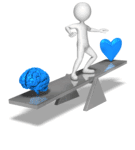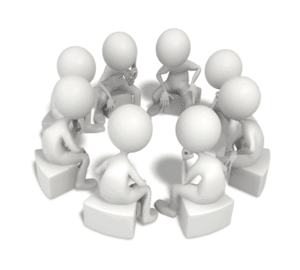 Improvement flows from change. Change flows from action. Action flows from decision.
Improvement flows from change. Change flows from action. Action flows from decision.
And we can make a decision in one of two ways – we can use guess-work or we can use grunt-work.
Of course it does not feel as black and white as that so let us put those two options at the opposite ends of a spectrum. Pure guess-work at one and and pure grunt-work at the other.
Guess-work is the easier end. To guess we just need a random number generator of some sort – like a dice. Grunt-work is the harder end. And what exactly is “grunt-work”?
Using available knowledge to work out a decision that will get us to our intended outcome is grunt-work. It does not require creativity, imagination, assumptions, beliefs, judgements and all the usual machinery that we humans employ to make decisions. It just requires following the tried-and-tested recipe and doing the grunt-work. A computer does grunt-work. It just follows the recipe we give it.
But experience shows that we even with hard work we do not always get the outcome we intend. So what is going wrong?
When the required knowledge is available and we do not use it we are exhibiting ineptitude. So in that context then we have a clear path of improvement: We invest first in dissolving our own ineptitude. We invest in learning what is already known. And that is grunt-work. Hard work.
When the required knowledge is not available then we are exhibiting ignorance. And our ignorance is exposed in two ways: firstly when we cannot make a decision of what to do because we have no option other than to guess. And secondly when what we predicted would happen as a result of our action did not actually happen. Reality disproved our rhetoric.
When we are ignorant we have a different path of improvement – first we need to do research to improve our knowledge and understanding, and only then when we are able to apply the new knowledge to make reliable predictions. We need tested and trusted knowledge to design a path to out intended outcome.
And as Richard Feynman perceptively observed … research starts with an educated guess. We might call it an hypothesis but it is a guess nevertheless. From that we make predictions and then we do experiments using reality to test our rhetoric. All guesses that fail the reality-check are rejected. So our vast body of scientific knowledge is the accumulation of guesses that did not fail the reality-check.
The critical word in the paragraph above is “educated”. How do researchers make educated guesses?
What does the word “educated” imply?
School is all about learning what is already “known”. There is no debate. The teachers are always right, only the students can be wrong. It is assumed.
But most of our learning comes from what we experience before and after school. We are all enrolled in the University of Life – and the teacher there is reality, not rhetoric.
And when we are tested by reality we are very often found to be lacking something. Well actually we are always found to be lacking. Sometimes we flunk the test outright and have to go back to the bottom of the learning ladder. Sometimes we scrape a bare pass … we survive … but we know we came close to failing. Sometimes we secure a safe pass … and still we know we could have done better. We can always do better.
But how? Is it because we were ignorant? Or was it because we were inept?
Examinations at The University of Rhetoric are designed to measure our ineptitude.
The University of Life is not so didactic or autocratic. The challenges it presents come from anywhere in the Ignorance-Ineptitude Zone. We need educated guesswork to survive there.
So one problem we face is how do we differentiate ignorance from ineptitude?
At this point it is important to separate individual ignorance from collective ignorance; and individual ineptitude from collective ineptitude. There are two dimensions at play.
The history of science is characterised by individuals who first resolved their individual ignorance when they discover something new. Only later was it appreciated that they were the first. So long as that discovery is shared then collective ignorance has reduced too. There is no need for everyone to rediscover everything when we share our learning.
Newton’s “discovery” of the Laws of Motion is a good example of an individual discovery quickly becoming collective knowledge. And with that collective knowledge we have proved we are able to land a spaceship on a far distant comet! That is grunt-work.
Einstein’s “discovery” of Relativity did not disprove Newton’s Laws of Motion, it re-framed and re-fined them so that even more profound predictions could be made. Some of the predictions are only now being tested as our technology has evolved to be able to perform the measurements with sufficient precision and accuracy. That is grunt-work. And it is increasingly collective grunt-work.
We are all born individually ignorant and individually inept.
Through experience and education we become aware of collective knowledge and with that we develop our individual capabilities. We do not re-invent every wheel.
And with that individual capability we are able to survive. We can secure a “pass” in the University of Life Survival Challenge.
But it leaves a lot of room for improvement.
Continuing to build collective knowledge through scientific research into more and more complicated and complex challenges, such as climate change, is necessary. But it is not sufficient. We need more.
Developing our collective capability to put that knowledge to the service of every living thing on the Earth is our challenge. And that is not grunt-work because we do not have a recipe to follow. We have to discover how to do that.
And that journey of discovery is called Improvement Science.




